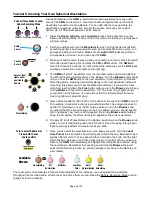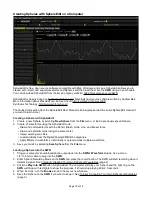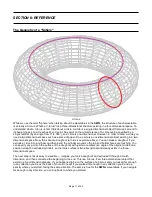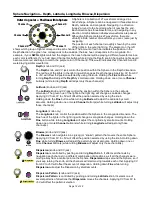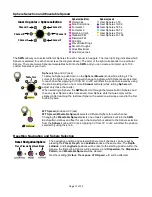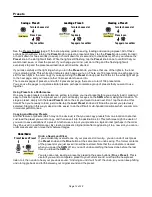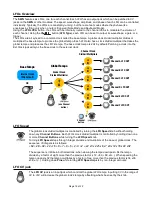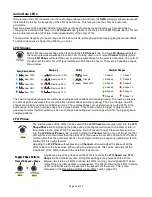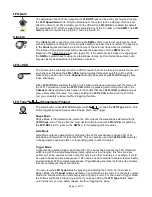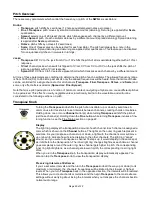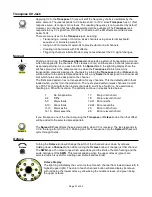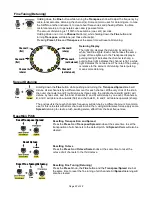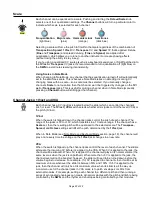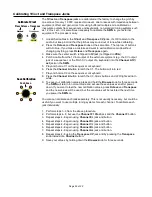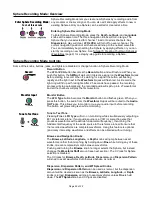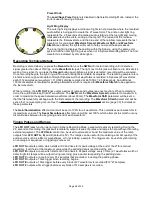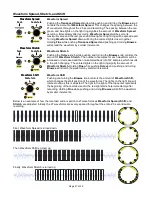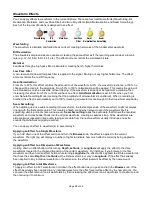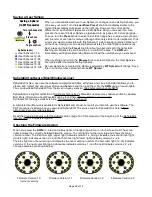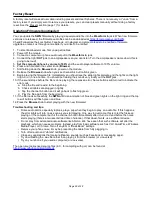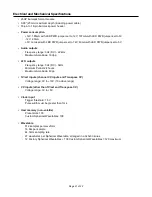
Scale
Each channel can be quantized to a scale. Pushing and turning the
Octave/Scale
knob
selects one of four quantization settings. The
Channel
buttons will turn a particular color to
indicate which scale is selected for each channel:
No quantization
Major scale
Harmonic minor
Semitones
(light blue)
(pink)
(orange)
(dark blue)
Selecting a scale will force the pitch to fit within that scale regardless of the combination of
Transposition
,
Spread
,
1V/oct
CV,
Transpose
CV, and
Spread
CV that’s applied. Detune
(
Fine
and
Transpose
) and spread detuning (
Fine
and
Spread
) are applied after
quantization, which allows you to tune to another instrument or create phasing effects
(without losing the ability to stay in key).
If you're using a quantized CV source (such as a keyboard, sequencer, or DAW) patched into
the
1V/oct
or
Transpose
CV jacks, it's recommended to turn quantization off (light blue) on
the
SWN
to avoid notes resolving inconsistently.
Using Scales in Note Mode
When changing to Note Mode, any channel that has quantization turned off will automatically
set to the semitones scale. This is because Note Mode relies on detecting incoming CV
changing notes within a scale – so a scale must be selected. If you manually change a
channel’s
Scale
to not quantize, then that channel won’t be triggered by changes on the
1V/
oct
or
Transpose
jacks. This is useful for muting a channel when in Note Mode (manually
pressing a
Channel
button
will still trigger that channel).
Channel Jacks: 1V/oct and VCA
Each channel has a CV input jack located below the slider which can control the channel’s
pitch or level. The
1V/oct | VCA
switch selects whether all six jacks control the level (VCA) or
the pitch (1V/oct).
1V/oct
When the switch is flipped down, the channel jacks control the pitch of each channel. The
range of the jacks is 0V to +10V, which translates to a 10 octave range. If the channel has a
Scale
set, then the resulting pitch will be quantized to the selected scale. The
Transpose,
Spread,
and
Octave
settings will offset the pitch determined by the
1V/oct
jack.
When in Note Mode (see Note Mode and Keyboard Mode section, page 18), the channel will
play a note every time the voltage on the
1V/oct
jack changes to a new note.
VCA
When the switch is flipped up, the channel jacks control the level of each channel. The sliders
attenuate the incoming CV before it’s applied to the VCA. When 0V is applied to the jack, the
channel will be silenced. When +5V is applied, the channel will play at its normal volume (the
same level as when the jack is unpatched). When more than +5V is applied to the jack, the
channel level will not be boosted; however, the slider will need to be turned down before the
volume begins to decrease. For example, if +10V is applied to channel A, then it will be at its
maximum volume whenever the slider is between 50% and 100%. If +5V is applied to the
jack, then the channel will only be at its maximum value when its slider is all the way up.
A common use for the channel jacks in VCA mode is to patch envelopes or LFOs from
external modules. For example, setting each channel to a different pitch and then running a
series of syncopated envelopes can create dynamic melodies with the pitch and timbre being
controlled by the
SWN
, and the rhythm and envelopes being controlled by other modules.
Page of
23
32
Octave
Scale

